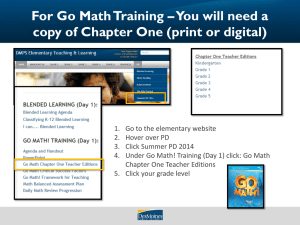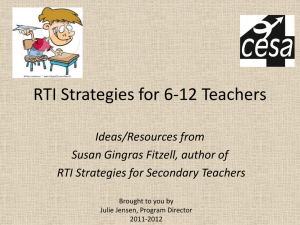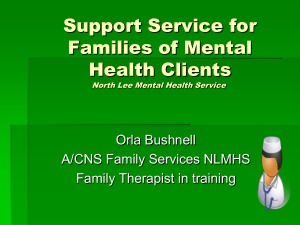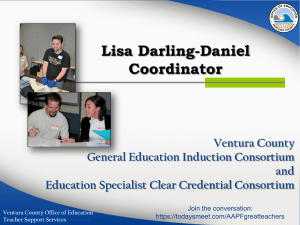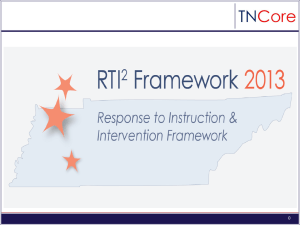Go Math - DMPS Elementary Teaching & Learning
advertisement
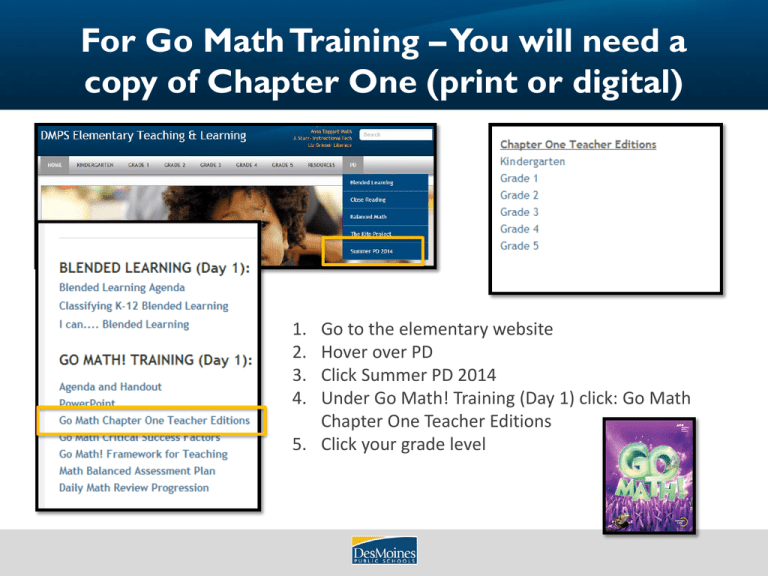
For Go Math Training – You will need a copy of Chapter One (print or digital) 1. 2. 3. 4. Go to the elementary website Hover over PD Click Summer PD 2014 Under Go Math! Training (Day 1) click: Go Math Chapter One Teacher Editions 5. Click your grade level Go Math! Training Grade Three 6.19.14 Dean Avenue Conference Center Agenda 1. Welcome & Agenda Overview 2. Go Math Organization and Curriculum Guides 3. Critical Success Factors for the Implementation of Go Math 4. Framework for Teaching Go Math (+Tech Integration) 5. Critical Success Factors for the Implementation of Go Math 6. Go Math Pacing and Assessment 7. Available Resources + Centers 8. Satisfaction Survey 9. Dismissal Norms Active Listening: • Self-monitor use of electronics • Follow along, take notes, etc… on your computer during the presentation today • Raise hand for individual assistance (so we can see you!) • Avoid working on other tasks – stay focused on the topic at hand Collaboration, Planning, Exploration Time: • Work with a partner or small group New Website elementary.dmschools.org Scavenger Hunt GO MATH! 2015 Covers look different than the 2012 Covers 3 GO MATH: CHAPTER ORGANIZATION Go Math: Organization Go Math: Organization Go Math: Content Development 2012 or 2015? 2012 • Resources on Think Central (including Teacher Editions) • Interactive White Board Lessons 2015 • Teacher Edition on Website • Teacher Edition on Table (even more updates) Go Math: Organization New to 2015 – Not in the current Chapter One Usage will be optional Vocabulary Game Vocabulary Writing Prompt Lesson Practice and Homework GO MATH: CURRICULUM GUIDE FORMAT Go Math: Curriculum Guide Go Math: Curriculum Guide Go Math: Curriculum Guide Go Math: Curriculum Guide Go Math: Curriculum Guide Go Math: Curriculum Guide Go Math: Curriculum Guide Suggested Chapter Pacing All lessons are paced for one day, unless otherwise indicated. Teachers may adjust to meet students’ needs. Year One of implementation will be a learning process. TIP: In planning – Check Chapters before and after and prior grade levels and next. Example: What strategies that are taught in 2nd grade may not make sense without looking at the strategies that were taught in 1st grade. GO MATH: CRITICAL SUCCESS FACTORS Go Math: Critical Success Factors Go Math: Critical Success Factors The following elements have been identified as critical success factors for the implementation of the Go Math materials during the 2014-2015 school year. Go Math: Critical Success Factors Launching the Chapter Show What You Know Pre-Assessment Vocabulary Activity Vocabulary Builder Grab and Go Centers School-Home Letter Go Math: Critical Success Factors Launching the Chapter Daily Math Review + Mental Math Show What You Know Pre-Assessment Grade 1 – 5: beginning of school year Vocabulary Activity Grade K: start of second semester Vocabulary Builder 15 minutes maximum Grab and Go Centers School-Home Letter 2-5 multi-step mental math problems daily Go Math: Critical Success Factors Launching the Chapter Daily Math Review + Mental Math Whole Group Concept Development Show What You Know Pre-Assessment Grade 1 – 5: beginning of school year “Engage” Digital Lesson Daily Vocabulary Activity Grade K: start of second semester “Explore” Lesson Daily Vocabulary Builder Hands-on Manipulatives 15 minutes maximum Grab and Go Centers School-Home Letter 2-5 multi-step mental math problems daily Guided Practice: “Explain” Share and Show Go Math: Critical Success Factors Launching the Chapter Daily Math Review + Mental Math Whole Group Concept Development Formative Assessment Show What You Know Pre-Assessment Grade 1 – 5: beginning of school year “Engage” Digital Lesson Daily Quick Check: Create Groupings Vocabulary Activity Grade K: start of second semester “Explore” Lesson Daily Vocabulary Builder Hands-on Manipulatives 15 minutes maximum Grab and Go Centers School-Home Letter 2-5 multi-step mental math problems daily Guided Practice: “Explain” Share and Show Go Math: Critical Success Factors Launching the Chapter Differentiated Instruction Small Group Instruction 3-5x week for students in need of additional support. Small Group Instruction 1-2x week for Advanced Students. Students Needing Additional Support: Personal Math Trainer daily Students not in small group will complete “On Your Own” and Math Centers. Daily Math Review + Mental Math Whole Group Concept Development Formative Assessment Go Math: Critical Success Factors Launching the Chapter Daily Math Review + Mental Math Differentiated Instruction Problem Solving Small Group Instruction 3-5x week for students in need of additional support. Utilize Problem Solving Interactive White Board example 15 minutes minimum daily Small Group Instruction 1-2x week for Advanced Students. Students Needing Additional Support: Personal Math Tutor daily Students not in small group will complete “On Your Own” and Math Centers. Whole Group Concept Development Formative Assessment Go Math: Critical Success Factors Launching the Chapter Daily Math Review + Mental Math Whole Group Concept Development Differentiated Instruction Problem Solving Management + Organization Small Group Instruction 3-5x week for students in need of additional support. Utilize Problem Solving Interactive White Board example Plan for differentiated instruction using Think Central Resources. 15 minutes minimum daily Small Group Instruction 1-2x week for Advanced Students. Students Needing Additional Support: Personal Math Tutor daily Students not in small group will complete “On Your Own” and Math Centers. Management system for use of technology. Organization of manipulatives Formative Assessment Go Math: Critical Success Factors Launching the Chapter Daily Math Review + Mental Math Whole Group Concept Development Formative Assessment Differentiated Instruction Problem Solving Management + Organization Intervention Small Group Instruction 3-5x week for students in need of additional support. Utilize Problem Solving Interactive White Board example Plan for differentiated instruction using Think Central Resources. Tier 3 15 minutes minimum daily Small Group Instruction 1-2x week for Advanced Students. Students Needing Additional Support: Personal Math Tutor daily Students not in small group will complete “On Your Own” and Math Centers. Fastt Math Management system for use of technology. Organization of manipulatives Go Math: Critical Success Factors Launching the Chapter Daily Math Review + Mental Math Whole Group Concept Development Formative Assessment Differentiated Instruction Problem Solving Management + Organization Intervention GO MATH: FRAMEWORK FOR TEACHING Go Math: Framework for Teaching Go Math: Framework for Teaching A Framework for Beginning our Implementation of the Go Math Materials • This instructional sequence to serve as a support for weekly planning when it feels as though “we can’t get it all in!” • Adjustments in regards to pacing and timing may be needed to meet the needs of students. • This should be considered a starting point as we work to become more efficient with the Go Math materials. FRAMEWORK FOR TEACHING: LAUNCHING THE CHAPTER Go Math Launching a New Chapter: Review Prerequisite Skills Activity Administer ‘Show What You Know’ Pre-assessment Preview Chapter Vocabulary Introduce Chapter Centers Send home School-Home Letter Go Math Launching a New Chapter: Review Prerequisite Skills Activity (prior to the pre-assessment) Go Math Launching a New Chapter Review Prerequisite Skills Administer ‘Show What You Know’ Pre-assessment Tier 2 + 3 Students for Chapter 1 • • Same group of students for the entire chapter. Students who need additional assistance with chapter concepts. Intervention What is Tier 1, Tier 2, Tier 3… Tier 1 = The Core Tier 2 = Small group intervention during 75 minute math block with a teacher (classroom or support) Tier 3 = Additional small group intervention outside of math block (or within a 90 minute math block) provided by a teacher (classroom or support) • Can be SPED or general education student Go Math: Pre-Assessment Go Math: Pre-Assessment Show What You Know Pre-Assessment Formative Assessment Purpose: Administered: Prior to beginning each chapter • Support small group instruction through the Developed by: process Go Math Data Teams Located: Teacher and Student Editions • Identify Tier 2 and Tier 3 students for the chapter • Diagnose student needs for small group interventions based on prerequisite concepts needed for the chapter • Identify gaps in whole group prerequisite skills – Whole group instruction will be adjusted Go Math: Pre-Assessment Show What You Know Pre-Assessment How will I know if a student is Tier 2 or Tier 3? Go Math Launching a New Chapter: Review Prerequisite Skills Activity Administer ‘Show What You Know’ Pre-assessment Preview Chapter Vocabulary Introduce Chapter Centers Send home School-Home Letter Do these activities the day before starting Lesson 1.1 Go Math Launching a New Chapter: Review Prerequisite Skills Activity Administer ‘Show What You Know’ Pre-assessment Preview Chapter Vocabulary (Developing Math Language and Vocabulary Builder) Introduce Chapter Centers Send home School-Home Letter Chapter One Scavenger Hunt: Find Tier 2 Prerequisite Skill Activity – Identify resources needed Find ‘Show What You Know’ Pre-assessment – How will you administer this? Find Developing Math Language page – Choose an activity Find Vocabulary Builder Identify the first 3 - 5 Grab and Go Centers listed FRAMEWORK FOR TEACHING GO MATH Go Math The Math Block: 75 – 90 minutes/day Daily Math Review Mental Math 2 – 5 Problems Whole Group Concept Development Engage Digital Lesson Explore – Whole Group Content Explain Guided Practice Quick Check Differentiated Instruction Teacher Small Group Independent/Center Work Personal Math Trainer Problem Solving Interactive White Board Daily Math Review + Mental Math Math Block: 75 – 90 minutes/day Daily Math Review Mental Math 2 – 5 Problems Daily Math Review + Mental Math (15 min maximum) We will be providing DMR modification suggestions for teachers in order to adjust the time to fit 15 minutes without changing the purpose and integrity of DMR. Does Daily Math Review have to be part of the math block of time? No. Daily Math Review and Mental Math can be a stand alone – similar to this year. Will the purpose and expectations of Daily Math Review be the same as this year? The purpose remains the same – which is to review prerequisite skills or skills that were not mastered in a previous Chapter. Go Math: Common Questions Daily Math Review + Mental Math elementary.dmschools.org Go Math The Math Block: 75 – 90 minutes/day Daily Math Review Mental Math 2 – 5 Problems Whole Group Concept Development – LESSON Engage Digital Lesson Explore – Whole Group Content Explain Guided Practice Quick Check Differentiated Instruction Teacher Small Group Independent/Center Work Personal Math Trainer Problem Solving Interactive White Board 1.2 Math Block: 75 – 90 minutes/day Whole Group Concept Development (5) Whole Group Concept Development Engage Digital Lesson Explore – Whole Group Content Explain Guided Practice Quick Check Daily Math Review + Mental Math Whole Group Concept Development (15 min maximum) (20 min) ENGAGE EXPLORE EXPLAIN Whole Group Concept Development Math Block: 75 – 90 minutes/day Whole Group Concept Development Engage Digital Lesson Explore – Whole Group Content Explain Guided Practice Quick Check Daily Math Review + Mental Math Whole Group Concept Development (15 min maximum) (20 min) ENGAGE INTRODUCTION Whole Group Concept Development Math Block: 75 – 90 minutes/day Whole Group Concept Development Engage Digital Lesson Explore – Whole Group Content Explain Guided Practice Quick Check • What are the benefits to using a simple interactive video to begin the lesson? • How will you use the Engage Video to introduce the lesson? Whole Group Concept Development Math Block: 75 – 90 minutes/day Whole Group Concept Development Engage Digital Lesson Explore – Whole Group Content Explain Guided Practice Quick Check Daily Math Review + Mental Math Whole Group Concept Development (15 min maximum) (20 min) ENGAGE EXPLORE WHOLE GROUP Whole Group Concept Development Math Block: 75 – 90 minutes/day Whole Group Concept Development Engage Digital Lesson Explore – Whole Group Content Explain Guided Practice Quick Check Whole Group Concept Development Math Block: 75 – 90 minutes/day Whole Group Concept Development Engage Digital Lesson Explore – Whole Group Content Explain Guided Practice Quick Check Daily Math Review + Mental Math Whole Group Concept Development (15 min maximum) (20 min) ENGAGE EXPLORE EXPLAIN GUIDED PRACTICE + FORMATIVE ASSESSEMNT Whole Group Concept Development Math Block: 75 – 90 minutes/day Whole Group Concept Development Engage Digital Lesson Explore – Whole Group Content Explain Guided Practice Quick Check Formative Assessment: Quick Check Differentiated Instruction (20-35 min) FORMATIVE ASSESSMENT Students needing additional support with lesson concept Formative Assessment: Quick Check Formative Assessment: Quick Check Quick Check Formative Assessment Purpose: Administered: Mid-Lesson DAILY (Explain) • Measure student understanding of Whole Group Instruction (Explore) Developed by: Go Math Located:toTeacher Student • Guidance teacherand on areas that Editions are not attained and need to be re-taught in Small Group Instruction • Indicator of student readiness for independent practice and problem solving • Real time adjustment to teaching and learning Formative Assessment Show What You Know: 1 per Chapter Quick Check: Daily Quick Check Students Tier 2 + 3 Students for Chapter 1 VS • • • Students needing additional support with lesson concept These students do not need intense support Different students daily . • • • • Same group of students for the entire chapter. Students who need additional assistance with Chapter Concepts Could be SPED or Gen-ed Different students each chapter Go Math The Math Block: Daily Math Review Mental Math 2 – 5 Problems Whole Group Concept Development Engage Digital Lesson Explore – Whole Group Content Explain Guided Practice Quick Check Chapter One Scavenger Hunt: Read through the 1.2 Explore lesson – Identify resources needed Find 1.2 Interactive White Board Lesson on Think Central – Will you utilize this? Find the 1.2 Quick Check – How will you check the quick check quickly? Go Math The Math Block: 75 – 90 minutes/day Daily Math Review Mental Math 2 – 5 Problems Whole Group Concept Development Engage Digital Lesson Explore – Whole Group Content Explain Guided Practice Quick Check Differentiated Instruction Teacher Small Group Independent/Center Work Personal Math Trainer Problem Solving Interactive White Board Intervention What is Tier 1, Tier 2, Tier 3… Tier 1 = The Core Tier 2 = Small group intervention during 75 minute math block with core teacher (or support) Tier 3 = Additional small group intervention outside of math block (or within a 90 minute math block) provided by support staff (or core) • Can be SPED or general education student *Differentiated Instruction Resources Go Math: Differentiated Instruction Small Group Intervention Resources… • Personal Math Trainer – Adaptive Intervention Program • Prerequisite skills and concepts • Tier 2 and 3 students identified through Show What You Know • September District PLC will focus on introducing Personal Math Trainer o May be available before the District PLC Go Math: Personal Math Trainer Personal Math Trainer • Students will have unlimited practices on key concepts supported by guided examples, step-by-step solutions, and video tutorials. • PMT analyzes each student’s personal strengths, weaknesses, preferences, and learning pace. • Generates reports for teachers so instruction can be tailored to meet the students’ needs. • PMT will automatically prescribe and create standards-based, personalized interventions for the students up to two grade levels below the current grade level. Go Math: Differentiated Instruction Small Group Intervention Resources… • Tier 2 Activity available on Think Central • 10 Minute lesson – same content – new way • Tier 2 and 3 students identified through Show What You Know • Students also identified through Quick Check • Currently available through 2012 Teacher’s Edition. Will be available on Think Central – as a link when Think Central is updated. Go Math: Differentiated Instruction How to access Tier 2 Lesson on 2012 Think Central: 1. Open the Teacher’s Edition 2. Find the current lesson of instruction. The page prior to the Engage will provide the Tier 2 lesson. Go Math: Differentiated Instruction Small Group Intervention Resources… • Strategic and Intensive Intervention Guides • • Tier 2 and Tier 3 Interventions (available for both SPED and general ed) Utilized for additional intervention Concept/Skill Prerequisites Go Math: Differentiated Instruction The next few slides outline what the Differentiated Instruction component may look like in a classroom. Thoughts to consider… • It will take 1 – 4 weeks to establish an effective small group instruction structure and routine. • Extra time has been built into chapter one at all grade levels • The small group instruction format will vary by school/classroom depending on the support staff available. • Interventions/Small Groups can be led by a classroom or support teachers. Go Math: CORE Differentiated Instruction Students needing more support with a particular lesson Tier 2 and Tier 3 students for the chapter (could be SPED or Gen Ed) Differentiated Instruction 20 minutes Small Group Instruction 3 – 5x per week Independent/ Collaborative Work 10 minutes: Tier 2 Activity available on Think Central Support Staff Push in/Pull Out During this Time 10 minutes: Guided Practice or Personal Math Trainer Formative Assessment Show What You Know: 1 per Chapter Quick Check: Daily Quick Check Students Tier 2 + 3 Students for Chapter 1 VS • • • Students needing additional support with lesson concept These students do not need intense support Different students daily . • • • • Same group of students for the entire chapter. Students who need additional assistance with Chapter Concepts Could be SPED or Gen-ed Different students each chapter Go Math: Differentiated Instruction Students needing more support with a particular lesson Tier 2 and Tier 3 students for the chapter (could be SPED or Gen Ed) Differentiated Instruction 20 minutes 20 minutes on Personal Math Trainer (Adaptive Prerequisites) 10 minutes Guided Practice with Teacher 10 minutes Math Centers 10 minutes On Your Own Skill Practice 10 minutes Advanced Learners Activity with Teacher Small Group Instruction (1-2x per week) Support Staff Push in / Pull Out During this Time Go Math: Special Education + Intervention Special Education + Intervention Daily Math Review + Mental Math Whole Group Concept Development (15 min maximum) (20 min) Education student is Can a SPED student What if a Special miss Daily Math Education student is out Review order to of the room in during whole receive group? SPED services? SPED students will be in Maybe. It depends on the classroom for Core the students and their Whole Group Instruction. needs and ability levels. Differentiated Instruction Problem Solving (20 min) (15 min) ENGAGE Small Group Instruction EXPLORE Independent / Collaborative EXPLAIN Personalized Learning Core Whole Group Instruction Go Math Math Block: 75 – 90 minutes/day Daily Math Review + Mental Math Whole Group Concept Development (15 min maximum) (20 min) Differentiated Instruction Problem Solving (35-40 (20 min) min) (15 min) Math Intervention: 15-20 minutes/day (**only for students in need of intensive support) Where do Special Education minutes fit into The Math Framework? Students may receive in-class or pull out support during the 20 minutes of Differentiated Instruction time. What might the classroom look like during the additional 15-20 minutes of Intervention? What are Tier 3 SPED students missing during intervention? One option would be to add 15-20 minutes to the Differentiated Instruction time for Math Intervention. The teacher would be working in small groups and students would be in centers. Go Math The Math Block: Daily Math Review Mental Math 2 – 5 Problems Whole Group Concept Development Engage Digital Lesson Explore – Whole Group Content Explain Guided Practice Quick Check Differentiated Instruction Teacher Small Group Independent/Center Work Personal Math Trainer Chapter One Scavenger Hunt: Find the On Your Own for Lesson 1.2 Brainstorm ideas with a partner on how to structure your small group time in the math block Go Math The Math Block: 75 – 90 minutes/day Daily Math Review Mental Math 2 – 5 Problems Whole Group Concept Development Engage Digital Lesson Explore – Whole Group Content Explain Guided Practice Quick Check Differentiated Instruction Teacher Small Group Independent/Center Work Personal Math Trainer Problem Solving Interactive White Board Go Math Math Block: 75 – 90 minutes/day Problem Solving Interactive White Board Daily Math Review + Mental Math Whole Group Concept Development (15 min maximum) (20 min) Differentiated Instruction Problem Solving (20 min) (15 min) Go Math The Math Block: Daily Math Review Mental Math 2 – 5 Problems Whole Group Concept Development Engage Digital Lesson Explore – Whole Group Content Explain Guided Practice Differentiated Instruction Quick Check Teacher Small Group Independent/Center Work Personal Math Trainer Problem Solving Interactive White Board Chapter One Scavenger Hunt: Find the Problem Solving in Lesson 1.2 Find the Problem Solving section of the Interactive White Board Lesson for Lesson 1.2 Brainstorm ideas with a partner on how you will use the Interactive White Board for Problem Solving Go Math The Math Block: 75 – 90 minutes/day Daily Math Review Mental Math 2 – 5 Problems Whole Group Concept Development Engage Digital Lesson Explore – Whole Group Content Explain Guided Practice Differentiated Instruction Quick Check Teacher Small Group Independent/Center Work Personal Math Trainer Problem Solving Interactive White Board GO MATH: CRITICAL SUCCESS FACTORS Go Math: Critical Success Factors Go Math: Critical Success Factors Launching the Chapter Daily Math Review + Mental Math Whole Group Concept Development Formative Assessment Show What You Know Pre-Assessment Grade 1 – 5: beginning of school year “Engage” Digital Lesson Daily Quick Check: Create Groupings Vocabulary Activity Grade K: start of second semester “Explore” Lesson Daily Vocabulary Builder Hands-on Manipulatives 15 minutes maximum Grab and Go Centers School-Home Letter 2-5 multi-step mental math problems daily Guided Practice: “Explain” Share and Show Go Math: Critical Success Factors Launching the Chapter Daily Math Review + Mental Math Whole Group Concept Development Formative Assessment Differentiated Instruction Problem Solving Management + Organization Intervention Small Group Instruction 3-5x week for students in need of additional support. Utilize Problem Solving Interactive White Board example Plan for differentiated instruction using Think Central Resources. Tier 3 15 minutes minimum daily Small Group Instruction 1-2x week for Advanced Students. Students Needing Additional Support: Personal Math Tutor daily Students not in small group will complete “On Your Own” and Math Centers. Fastt Math Management system for use of technology. Organization of manipulatives MATH ASSESSMENT PLAN WHAT WILL PLC / DATA TEAMS LOOK LIKE IN 2014-2015? How might the Data Team/PLC structure look different in 2014-2015? Having conversations around what instruction will look like at the teacher and student level. – Focus on the use of Go Math – Engagement techniques within Go Math – Opportunities for collaborative practice using the new materials and technology. – Use of the Show What You Know assessment to differentiate instruction and plan for small group time. Elementary Math Assessment Plan Elementary Math Assessment Plan Elementary Math Assessment Plan Show What You Know Pre-Assessment Formative Assessment Purpose: Administered: Prior to beginning each chapter • Support small group instruction through the Developed by: process Go Math Data Teams Located: Teacher and Student Editions • Identify Tier 2 and Tier 3 students • Diagnose student needs for small group interventions based on prerequisite concepts needed for the chapter • Identify gaps in whole group prerequisite skills – Whole group instruction will be adjusted Elementary Math Assessment Plan Show What You Know Pre-Assessment Formative Assessment Elementary Math Assessment Plan Elementary Math Assessment Plan Quick Check Formative Assessment Purpose: Administered: Mid-Lesson DAILY (Explain) • Measure student understanding of Whole Group Instruction (Explore) Developed by: Go Math Located:toTeacher Student • Guidance teacherand on areas that Editions are not attained and need to be re-taught in Small Group Instruction • Indicator of student readiness for independent practice and problem solving • Real time adjustment to teaching and learning Elementary Math Assessment Plan Elementary Math Assessment Plan Chapter Posttest (Recommended) Formative / Summative Assessment Purpose: Administered: End of a chapter • Measure attainment of standards from chapter Developed by: Go Math •(Revised Give guidance teacher to reteach, change by DatatoTeams/PLC) strategies, and identify student needs before end of Located: Assessment Guide semester/year (Think Central) • Predictor of success on standards based assessments • Possibly used as part of a student grade • Identify content not mastered – Daily Math Review How Might PLC / Data Teams Look Different? Posttest Data Team RECOMMENDED Structure Assess your readiness level: • How frequent Math Data Teams meet • Use of the data to differentiate instruction Elementary Math Assessment Plan Elementary Math Assessment Plan Quarterly District Standard Assessment District Standards Based Assessment Purpose: Administered: Quarterly • Comprehensive measure grade level attainment of standards Developed by: Go Math (Revised by DMPS District Team) • Use to inform instructional pacing and strategies Located: Math Website (Available in August) • Possibly used as part of student grade determination • Evaluate Go Math as a system • Assist in identifying gaps in all previously instructed standards – Daily Math Review Math Data Teams elementary.dmschools.org Elementary Math Assessment Plan Elementary Math Assessment Plan Scholastic Math Inventory (SMI) External Interim Assessment Purpose: Administered: Fall, Winter, Spring • Monitor student progress towards Algebra Readiness Developed by: Scholastic Located: • Show whatSAM needs to be addressed to meet student needs • Assess Fact Fluency for FASTT Math Intervention Groups • Assist in identifying gaps in prerequisite skills – Daily Math Review Elementary Math Assessment Plan How Might PLC / Data Teams Look Different? Pretest Data Team OPTIONAL Structure Assess your readiness level: • How frequent Math Data Teams meet • Familiarity with Go Math materials in order to differentiate Elementary Math Assessment Plan Chapter Pretest (Optional) Common Formative Assessment Purpose: Administered: Prior to beginning a chapter • Support whole group instruction through the data team process by: Go Math Developed (evaluated and revised by Data Teams/PLCs) • Allows for customization of instructional content to Located: Assessment Guide (Think Central) optimize the time spent teaching specific objectives Elementary Math Assessment Plan GO MATH RESOURCES Go Math AVAILABLE RESOURCES Technology Interactive White Board Lessons Fastt Math Engage Digital Lesson Personal Math Trainer Interactive Student Edition iTools Professional Development Videos Strategic and Intensive Intervention Guides Tier 2 Lessons on Think Central (through Teacher’s Edition) Grab and Go Centers Bold – Access Daily Italic – Will be available through Think Central soon Games Literature Activity Activity Book Go Math: Differentiated Instruction Grab and Go Centers Games (G):(L): Practice skillsmath and apply Literature Integrate skills into concepts these ready-to-use real worldwith situations and cross-curricular Activity Cards (A): Readymade, easyinteractive math Students can subject matter toadventures. engage student interest. to-follow activities help students play these games in pairs oron small Interactive questions focus key groups. reinforce or extend concepts and skills. concepts and support comprehension. *Includes cards for Challenge/Enrichment. Go Math: Math Centers Go Math: Math Centers Go Math: Math Centers Go Math: Math Centers “Good-to-Knows” about the Grab and Go Kits • Organizing a chapter at a time will make managing the components simpler. Some activities, games, and literature books may occur in future chapters. • Each activity card (blue, orange or purple) needs a student copy from the grab and go teacher book and sometimes other materials too. (Dice, counters, base ten blocks) • Some of the manipulatives required for the activity only come with paper/fold manipulatives so before you turn in old manipulatives – you may want to check on what you need for the centers and Tier 2 activities. • There is only 1 literature book and 1 copy of the game. You will probably need to make more copies of the game boards. Go Math AVAILABLE RESOURCES Technology Interactive White Board Lessons Fastt Math Engage Digital Lesson Personal Math Trainer Interactive Student Edition iTools Professional Development Videos Strategic and Intensive Intervention Guides Tier 2 Lessons on Think Central (through Teacher’s Edition) Grab and Go Centers Bold – Access Daily Italic – Will be available through Think Central soon Games Literature Activity Activity Book Go Math: Think Central Go Math: Think Central Go Math: Think Central Go Math: Scavenger Hunt Let’s find some resources… Log on to Think Central Under Resources – Click List Select Grade Level, Math, and English Find Resources Interactive White Board Lessons – Problem Solving Teacher Edition – Tier 2 Lesson Grab & Go Activity Guide Other Think Central Resources Log on to the New Elementary Website Find Curriculum Guide for Chapter One Find Year at a Glace for Chapter One Review Pacing https://www.surveymonkey.com/s/elementarysummerpd COLLABORATE, PLAN, AND EXPLORE PLEASE COMPLETE THE SURVEY: HTTPS://WWW.SURVEYMONKEY.COM/S/ELEMENTARYSUMMERPD
